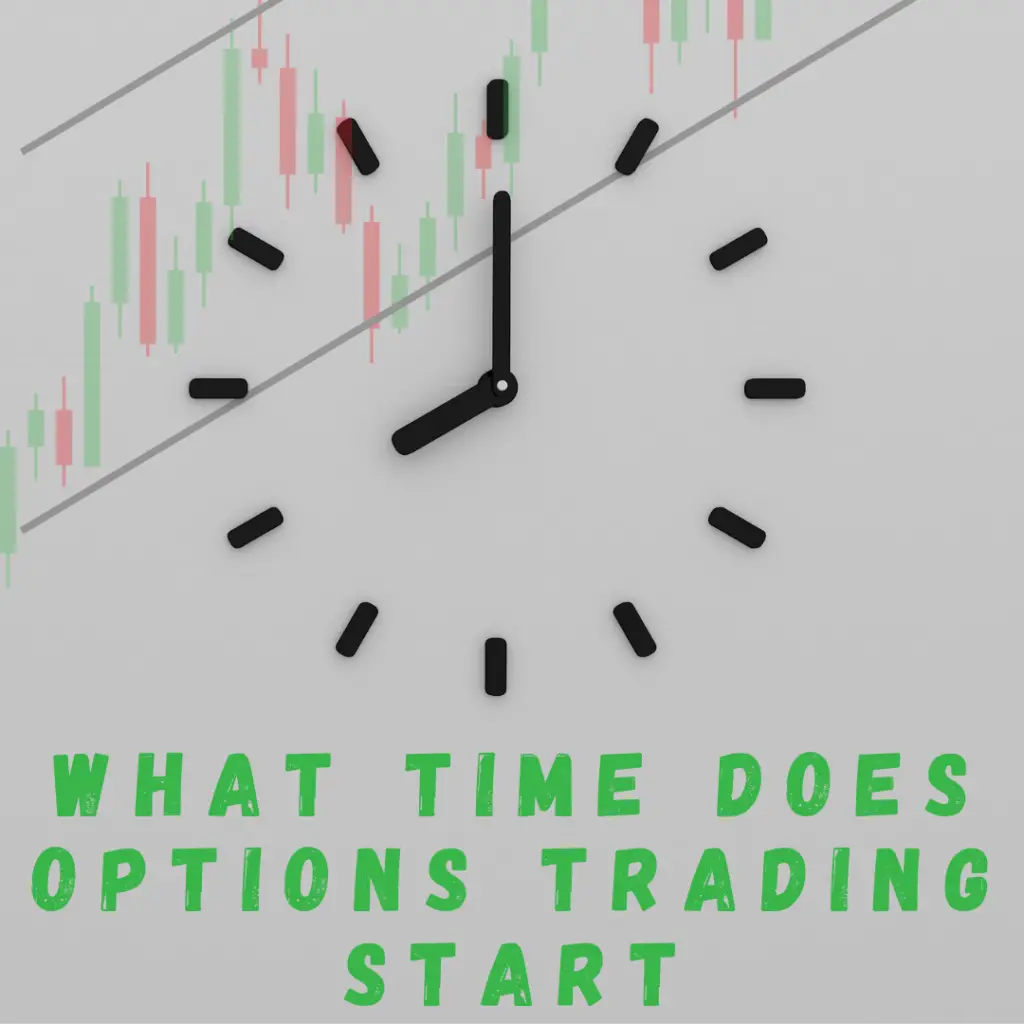Options trading offers a unique opportunity for investors to leverage their positions and potentially reap significant rewards. Knowing when options trading starts is crucial for strategizing and making informed decisions. This means being able to:
- Check the latest news and information
- Update and look into the profit and loss spreadsheet(if you have one)
- Read up on companies’ PnL and earnings before making any trade
Options trading on the U.S. stock exchanges generally follows a specific schedule:
- Pre-Market Hours: Some brokerages allow trading to begin as early as 4:00 AM Eastern Time (ET). During this time, investors can place orders to buy or sell options before the regular market session begins.
- Regular Trading Hours: The official trading hours for options on the U.S. exchanges are from 9:30 AM to 4:00 PM ET, Monday through Friday. This period is when most trading activity occurs, and prices are determined based on supply and demand.
- After-Hours Trading: After the regular market closes at 4:00 PM ET, some brokerages offer extended hours trading until 8:00 PM ET. However, options trading volume during this time is typically lower, and prices may be more volatile due to fewer participants.
It’s essential to check with your specific brokerage firm to confirm their trading hours and any limitations or requirements they may have for options trading. Additionally, different exchanges around the world may have trading hours for options, so it’s important to be aware of the relevant time zone and market regulations.

Learning how to trade options is all about understanding the small details and reasoning behind each trade. I enjoy this book about options trading and I believe you will learn tremendously from it.
Read the book and let me know what you think:
So now you know the importance, here’s a guide on options trading hours, the process of getting started, the mechanics involved, the various platforms available, and the associated risks and rewards.
With insights into standard market hours, pre-market and after-hours trading, and broker-specific nuances, readers will gain the knowledge needed to navigate the options trading landscape effectively.
Key Takeaways
- Standard options trading hours typically align with the stock market, running from 9:30 a.m. to 4:00 p.m. ET.
- Pre-market options trading can occur from 4:00 a.m. to 9:30 a.m. ET, while after-hours trading is available from 4:00 p.m. to 8:00 p.m. ET, depending on the brokerage.
- Options contracts are agreements that give the buyer the right, but not the obligation, to buy or sell an asset at a specified price by a certain date.
- Options can be traded on specialized exchanges like the CBOE, and the availability of trading sessions can be influenced by stock market holidays.
- Options trading is high-risk and high-reward, offering the potential for significant gains, but also the risk of total loss, compared to traditional stock trading.
what time does options trading start

Options trading within the standard market hours typically align with the regular trading sessions of the stock exchanges.
For North American exchanges, such as the Nasdaq Stock Market and the New York Stock Exchange (NYSE), these hours are generally from 9:30 a.m. to 4:00 p.m. Eastern Time (ET). It’s important to note that these times can vary slightly depending on the specific exchange and the type of options being traded.
While the core hours are set, investors should be aware of the possibility to trade outside these times. Pre-market and after-hours sessions extend the potential trading window, although participation in these sessions may depend on your broker’s offerings.
Here is a quick overview of the standard market hours across different time zones:
- Eastern Standard Time (EST) – New York: 9:30 AM – 4:00 PM
- Central Standard Time (CST) – Chicago: 8:30 AM – 3:00 PM
- Mountain Standard Time (MST) – Denver: 7:30 AM – 2:00 PM
- Pacific Standard Time (PST) – Los Angeles: 6:30 AM – 1:00 PM
Remember, these times are for when the majority of options trading occurs, but your broker may offer additional windows for trading, reflecting the diverse needs of investors.
Pre-Market and After-Hours Trading
Options trading isn’t confined to the standard market hours. Investors can also participate in pre-market and after-hours sessions, which offer opportunities to trade outside of the typical 9:30 a.m. to 4:00 p.m. Eastern Time window. These extended hours can be particularly useful for reacting to news events that occur outside of regular trading hours.
Pre-market trading generally occurs from 4:00 a.m. to 9:30 a.m. ET, while after-hours trading typically extends from 4:00 p.m. to 8:00 p.m. ET. However, these hours can vary depending on the brokerage platform you use. For example, some platforms may restrict pre-market trading to a shorter window, such as 9:00 to 9:30 a.m. ET.
It’s important to note that not all options are available for trading during these extended hours, and liquidity can be lower, which might result in wider bid-ask spreads. Here’s a quick rundown of what to expect:
- Pre-market and after-hours trading is available for many, but not all, securities.
- Extended hours trading involves additional risks due to increased volatility.
- Brokerages may have specific requirements or restrictions for participating in extended-hours trading.
Broker-Specific Trading Hours
While standard options trading hours are set from 9:30 AM to 4:15 PM EST, many brokers offer additional trading sessions outside these times. Pre-market and after-hours trading can significantly extend the window in which you can trade options. For example, some platforms allow pre-market trading as early as 4 AM ET and after-hours trading until 8 PM ET. However, these extended hours can vary widely among brokers.
Broker-specific trading hours may also be influenced by the type of options and the exchanges they are traded on. It’s essential to check with your individual broker for their specific trading hours, as they may have unique rules or limitations. For instance, SoFi Invest limits pre-market trading to a brief window from 9 to 9:30 AM ET but offers a more extended after-hours session.
Remember, trading outside of the standard market hours can involve additional risks due to lower liquidity and higher volatility. It’s crucial to understand these risks and how they can affect order execution.
Here’s a quick reference for some common broker-specific trading hours:
- Pre-market trading: 4 AM to 9:30 AM ET
- Standard trading: 9:30 AM to 4:15 PM ET
- After-hours trading: 4 PM to 8 PM ET
Always verify these times with your broker, as they may have different schedules or offer additional services like off-hour trade reports.
Getting Started with Options Trading
Options are contracts that grant the holder the right, but not the obligation, to buy or sell an underlying asset at a predetermined price before a certain date. Each option contract typically represents 100 shares of the underlying stock, allowing investors to leverage their position with less capital than purchasing the stock outright.
Options come in two main types: call options and put options. A call option gives the buyer the right to purchase the asset, while a put option gives the right to sell it. Here’s a simple breakdown:
- Call Option: Right to buy
- Put Option: Right to sell
Options trading can be a powerful tool in an investor’s portfolio, offering the ability to generate income, hedge against market movements, and speculate on market trends with limited risk.
The versatility of options allows for a wide range of strategies, from basic to complex. Investors can use options to bet on the direction of the market, hedge existing positions, or gain exposure to a stock with a smaller initial investment.

Learning how to trade options is all about understanding the small details and reasoning behind each trade. I enjoy this book about options trading and I believe you will learn tremendously from it.
Read the book and let me know what you think:
Finding an Options Broker
When venturing into the world of options trading, selecting the right broker is a pivotal step. Look for a broker that supports options trading and aligns with your financial goals, considering factors such as fees, platform usability, customer service, and educational resources. A balance between cost and features is essential.
Here are some steps to guide you through the process:
- Identify your trading needs: Whether you prioritize low costs or require a comprehensive trading platform, options are plentiful. Apps like Webull or Robinhood cater to cost-conscious traders, while other brokers offer more robust features.
- Get approved for options trading: Most brokers necessitate an options approval form, which assesses your financial situation and trading experience. Approval levels vary, with basic strategies like covered calls requiring less scrutiny than advanced plays like straddles.
- Educate yourself: Options trading has a steep learning curve. Brokerages will require you to digest educational material and understand their order handling for options.
It’s crucial to not only find a broker but to ensure you are equipped with the knowledge and tools to navigate the complexities of options trading.
Investopedia’s list of the best online brokers for options trading can be a valuable resource for getting started. Remember, education, guidance, and strategy are key to success in this intricate market.

Looking to start investing, why not try Tiger Broker?
Tiger Brokers offers competitive commission fees for trades across different markets.
It is also practically fee-less in these aspects: no custody fees, deposit (or withdrawal) fees, currency exchange fees, inactivity fees, or account maintenance fees to contend with!
Placing Your First Options Trade
After selecting a broker and creating a trading plan, the next step is to place your first options trade. This involves a few critical decisions:
- Decide on the type of option you want to trade, whether it’s a call or a put.
- Determine your target strike price and expiration date based on your market analysis and trading plan.
- Place your trade using a limit order to control the price you’re willing to pay or receive.
It’s essential to manage your risk carefully and never trade with more money than you can afford to lose. Options trading can be lucrative, but it also carries significant risk.
Remember to research your trade thoroughly. Understand the company and its competitive situation to make an informed decision. Start with education and perhaps paper trading to gain experience before committing real capital.
The Mechanics of Options Trading

The Basics of Options Contracts
Options contracts are fundamental instruments in the financial markets that provide traders with the flexibility to implement various strategies. An options contract gives the holder the right, but not the obligation, to buy or sell an underlying asset at a specified strike price on or before a certain date. There are two main types of options: call options and put options.
- Call options allow the holder to buy the asset at the strike price.
- Put options give the holder the right to sell the asset at the strike price.
Each contract typically represents 100 shares of the underlying stock, making options a powerful tool for investors seeking leverage. For example, rather than purchasing 100 shares of a stock at the full market price, an investor could buy a call option with a much smaller investment, potentially magnifying both profits and losses.
Options trading can be seen as a way to speculate on the future prices of securities, offering strategic market flexibility and the potential for high returns.
It’s important to understand that options trading involves significant risks and is not suitable for all investors. The leverage provided by options can amplify losses as well as gains, and it’s crucial to have a solid understanding of the mechanics before diving in.
Order Types in Options Trading
When trading options, understanding the different types of orders is crucial for executing strategies effectively. Principal orders allow traders to manage risk by setting a specific price for transactions. These include market orders, which execute at the current market price, and limit orders, which set a maximum or minimum price at which you are willing to buy or sell an option.
Options trading platforms offer a variety of order types to suit different trading strategies and risk profiles.
For instance, Bybit provides basic order types such as Market Order, Limit Order, and Conditional Order. Kraken supports options that specify what is bought or sold, including the size and volume of the order. It’s important to note that using a limit order is recommended to avoid unexpected prices.
Lastly, certain strategies like the short straddle involve selling calls and puts with the same strike price and expiration date, highlighting the need for a deep understanding of order types and their implications.
Understanding Expiration Dates and Strike Prices
The expiration date of an option is a critical factor in options trading. It marks the moment when the option contract is no longer valid, and the right to exercise it ceases. Options can have expiration dates ranging from days to several years, with long-term options known as LEAPS.
Strike prices are equally pivotal, indicating the price at which the option can be exercised. For a call option, it’s the price you can buy the underlying asset, and for a put, the price you can sell. Understanding the relationship between the market price of the underlying asset and the strike price is essential for successful options trading.
The value of an option is not just determined by its intrinsic value, but also by its time value, which diminishes as the expiration date approaches. This decay in time value is a crucial concept for options traders to grasp.
Here’s a simple breakdown of an option’s components:
- Expiration: The last day the option is valid.
- Strike Price: The agreed-upon price for the option exercise.
- Time Value: The potential for the option to gain value before expiration.
- Intrinsic Value: The actual profit if exercised at the current market price.
Trading Options on Different Platforms

Pre-open market sessions are a critical time for traders looking to capitalize on market movements resulting from overnight news or events.
Most traders can participate in pre-open market sessions, but it’s not always a default feature provided by brokers. Due to the heightened volatility and lower volume, brokers may require traders to request activation of this feature.
During these sessions, traders can employ a pre-open market strategy to mitigate the impact of significant volatility. It’s important to note that not all orders may be executed during this time. For instance:
- Limit orders not matched will carry over to the normal session at the same price.
- Market orders not matched will move to the normal session at the opening price, or the previous day’s closing price if the opening price isn’t determined.
Pre-market trading allows investors to assess market sentiment and make strategic decisions as developments unfold. While it offers the opportunity to react swiftly to news, it also carries additional risks compared to standard trading hours.
Options Trading on Specialized Exchanges
Options trading extends beyond the standard equity markets and into the realm of specialized exchanges. These platforms, such as the Chicago Board Options Exchange (CBOE), the Boston Options Exchange (BOX), and the International Securities Exchange (ISE), cater specifically to options traders. Unlike traditional stock exchanges, these specialized exchanges offer a variety of contracts, including those on futures and indexes.
Trading on these exchanges is largely electronic, ensuring efficient and rapid execution of orders. It’s important to note that while individual companies have no control over whether options on their shares are traded, the exchanges themselves decide based on specific listing criteria.
For those interested in trading options on futures, it’s worth noting that markets like these operate nearly six days a week, providing ample opportunity for traders. The Cboe Global Markets, for instance, accepts certain types of orders as early as 2:00 a.m. ET, catering to a wide range of trading strategies.
Here’s a quick look at some specialized exchanges and their unique offerings:
- CBOE: Known for a wide array of options, including zero-day contracts.
- BOX: Offers innovative trading features and strategies.
- ISE: Focuses on international options markets.
Each exchange has its own set of rules and hours, which can sometimes differ from standard market hours. For example, the Nasdaq has introduced new contracts that expire on Wednesdays, adding more flexibility to the traditional Friday expirations.
The Impact of Stock Market Holidays on Options Trading
Stock market holidays can have a significant impact on options trading. Options sellers thrive in uncertain markets by providing insurance to buyers, and holidays can introduce additional volatility. For instance, the options expiration week effect is a phenomenon where the market may experience increased volatility due to the expiration of options contracts.
Market fluctuations are common around holidays, with potential market dips and spikes. Traders should be aware of these patterns and adjust their strategies accordingly.
Here is a list of major stock market holidays when options trading is affected:
- New Year’s Day
- Martin Luther King, Jr. Day
- Presidents’ Day
- Good Friday
- Memorial Day
- Juneteenth Holiday
- Independence Day
- Labor Day
- Thanksgiving Day
- Christmas Day
During these holidays, not only is the trading of underlying stocks halted, but the trading of derivatives like options and futures is also impacted. It’s essential for traders to plan their strategies around these dates to avoid unexpected market closures.
Risks and Rewards of Options Trading

The High-Risk, High-Reward Nature of Options
Options trading is often characterized by its high-risk, high-reward nature. Traders are drawn to the potential for significant profits, which can be much larger, in percentage terms, than those from traditional stock trading. However, this potential comes with substantial risks.
The allure of options lies in their leverage; a relatively small investment can control a substantial amount of stock. This leverage can amplify gains, but it also magnifies losses, especially since options can expire worthless, leading to a total loss of the initial investment.
The risk/reward ratio is a critical concept in options trading, marking the prospective reward against the risk undertaken. A disciplined approach to this ratio is essential for successful trading.
Here are some key points to consider:
- Options can provide high returns over a short period, allowing for rapid capital growth if predictions are correct.
- The cost of obtaining exposure to a stock’s price movement through options can be lower than purchasing the stock outright.
- Options prices are volatile, offering traders the chance to profit from even minor fluctuations in the underlying stock’s price.
Comparing Options Trading to Stock Trading
Options trading and stock trading are two distinct approaches to the market, each with its own set of characteristics and potential outcomes. Options trading offers higher flexibility and potential returns, but also comes with a unique set of risks. Stocks, on the other hand, represent a fractional ownership interest in a company and tend to provide a more straightforward, long-term growth approach.
While an option can lose its entire value after a certain date, stocks generally retain value indefinitely, making them a more stable investment in the long run.
Options allow investors to trade not only based on stock moves but also on the passage of time and changes in volatility. This multi-dimensional aspect of options trading can be advantageous, but it requires a deeper understanding of the market dynamics. In contrast, stock trading is often seen as less complex, with the value of the investment tied directly to the company’s performance.
Here’s a quick comparison:
- Options: Side bet among traders, expires after a set time, potential for high returns at greater risk.
- Stocks: Fractional ownership, retains value over time, straightforward long-term growth.
Managing Risks in Options Trading
When engaging in options trading, managing risk is paramount to long-term success. Traders often employ various strategies to mitigate potential losses. For instance, hedging strategies can be used to balance positions, aiming to offset losses in one with gains in another. Additionally, combining different options strategies can provide a more robust defense against market volatility.
Options trading is not inherently riskier than stock trading, but it does require a careful approach to risk management. This involves understanding the specific risks associated with options and taking steps to limit financial exposure. A risk reversal strategy, for example, can offer downside protection while limiting upside potential, balancing the risk-reward equation.
It’s essential to recognize that options can expire worthless, leading to a total loss of the initial investment. Therefore, traders must be diligent in doing everything within their power to limit financial risk.
Ultimately, the goal is to align options trading activities with personal risk requirements, ensuring that each trade fits within an individual’s risk tolerance and investment strategy.
Is Options Trading for You?
Whether you’re a seasoned trader or just starting out, understanding the basics of options and the trading procedures can help you navigate the complexities of the options market and make informed decisions.

Learning how to trade options is all about understanding the small details and reasoning behind each trade. I enjoy this book about options trading and I believe you will learn tremendously from it.
Read the book and let me know what you think:
Frequently Asked Questions
What time does options trading start?
Standard options trading hours on major exchanges are from 9:30 a.m. to 4 p.m. ET during regular business days. However, you can also trade during pre-market hours from 4 a.m. to 9:30 a.m. ET and after-hours from 4 p.m. to 8 p.m. ET, depending on your brokerage.
Can I trade options during pre-market hours?
Yes, pre-market options trading is possible from 4 a.m. to 9:30 a.m. ET, but availability may vary depending on your broker. For example, SoFi Invest offers pre-market trading from 9 a.m. to 9:30 a.m. ET.
Are options trading hours affected by stock market holidays?
Yes, options trading hours are impacted by stock market holidays. Trading is typically unavailable on these days, and you should check the specific holiday schedule for the year to plan your trades accordingly.
What are options in trading?
Options are contracts that give the holder the right, but not the obligation, to buy or sell an underlying asset at a specified price on or before a certain date. They can be used for speculation or hedging purposes.
How do I start trading options?
To start trading options, you need to find a suitable options broker, open a trading account, and then place your first trade using a limit order to control the price at which you enter the market.
What are the risks and rewards of options trading?
Options trading is high-risk and high-reward. Traders can potentially multiply their investment in a short period, but there’s also the risk of losing the entire investment if the option expires worthless.





